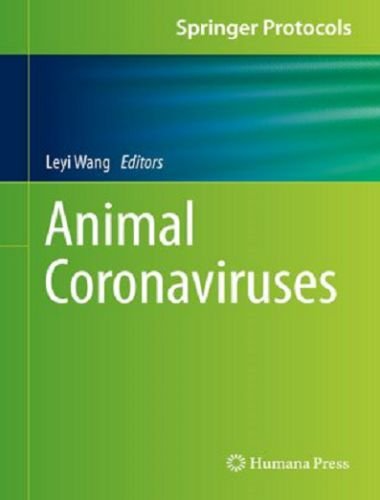Animal Coronaviruses by Leyi Wang, This detailed volume provides diagnosticians and researchers with practical methodologies and approaches to tackle animal coronaviruses.
Animal Coronaviruses 1st Edition

It explores conventional immunohistochemistry, virus neutralization, enzyme-linked immunosorbent assays, expression and purification of recombinant viral proteins, and various molecular assays, including conventional and real-time reverse transcription-PCR, reverse genetics methodology, and next generation sequencing and sequence analyses. As part of the Springer Protocols Handbooks series, chapters contain readily reproducible laboratory protocols as well as expert tips on troubleshooting and avoiding known pitfalls.
Practical and authoritative, Animal Coronaviruses serves as an ideal reference for researchers examining a wide variety of coronavirus species in the Coronaviridae.
The first coronavirus, avian infectious bronchitis virus, was isolated from chicken eggs in 1937. Porcine transmissible gastroenteritis virus and mouse hepatitis virus were subsequently identified from pigs and mice, respectively, in the 1940s. In the following decades, while the human coronaviruses were identified in the 1960s, other animal coronaviruses including porcine hemagglutinating encephalomyelitis virus (1962), feline coronavirus (1970), canine coronavirus (1971), bovine coronavirus (1973), turkey coronavirus (1973), porcine epidemic diarrhea virus (1978), and porcine respiratory coronavirus (1984) were also discovered.
In order to study coronaviruses, various systems of reverse genetics have been established since 1992 for understanding viral replication, elucidating virus-host interaction and pathogenesis, and developing novel coronavirus vaccines. Because a high- throughput next-generation sequencing technology was unveiled in 2005, its application in virology has advanced a new era of coronavirus discovery. Several emerging animal coronaviruses, such as porcine delta coronaviruses, therefore, have been identified and characterized. Although there are diverse animal coronavirus species, this handbook is primarily focused on coronaviruses of domestic animals and poultry. This handbook is intended to summarize the currently avail-able technologies that have been developed and utilized to make the progress of coronavirus virology possible.
The purpose is to provide the diagnosticians and researchers with practical methodologies and approaches to tackle animal coronaviruses, which cover the conventional immunohistochemistry, virus neutralization, enzyme-linked immunosorbent assays, expression and purification of recombinant viral proteins, and various molecular assays, including conventional and real-time reverse transcription- PCR, reverse genetics methodology, and next-generation sequencing and sequence analyses. Furthermore, it is reasonable to expect that the methodologies and approaches highlighted in this handbook are applicable to other coronavirus species in the Coronaviridae .
| PDF Size: 6 MB | Book Download Free |
Password: pdflibrary.net

ewhere is the link
Link at end of the post